A System for the Continuous Directed Evolution of Biomolecules
Background
Engineering of enzymes and other biological materials has been a central problem for bioengineering for over a dozen years. The advent of directed evolution has allowed for engineers to screen through an unprecedented number of variants and better understand the sequence to function relationship of these molecules1. However, screens to find which variants are capable of a desired outcome and multiple rounds of ex vivo mutagenesis limit such efforts. An evolution on the current methods would allow one to simultaneously vary a protein of interest in vivo and then screen for functionality. In this work, the authors decide to tackle exactly this problem and have invented a method they call ACE: automated continuous evolution.
Key Findings
In this preprint, the authors set out to develop a method to evolve proteins in live cells using the advantages of feedback control. In a beautiful collaboration, two groups that independently made advances on this problem came together to invent a technology that absorbs the best features of their respective systems. The Liu group recently created OrthoRep, which is a system for targeted, in vivo mutagenesis of a gene of interest2. Essentially, they use a error-prone, orthogonal DNA polymerase-plasmid pair to mutate genes of interest in yeast achieving a 100,000 fold increase in mutation rate to drive accelerated evolution. The Khalil group developed eVOLVER which is a continuous culture platform that allows one to control multiple parameters and apply selective pressures using feedback control and real-time monitoring of growth speeds3. Because this system is completely automated, the system does not need to rely on a priori selection schedules or algorithmic selection routines that can drive the culture to an oscillatory growth regime or overshoots leading to culture extinction. In the ACE system, the authors set up eVOLVER to have two media inputs: (1) 'no selection' base media and (2) 'full selection' media that had maximum amount of drug or no nutrient. The system then would read out the OD of the culture and appropriately mix the two input medias to apply a constant pressure to drive the growth of the culture to a specific OD using a closed loop proportional-integral-derivative controller (Fig 1).

As a first test, the authors wanted to evolve Plasmodium falciparum dihydrofolate reductase (PfDHFR) to get drug resistance to pyrimethamine. To accomplish this, the authors encoded PfDHFR on OrthoRep in yeast that needed this protein for survival. They then found put these cells in eVOLVER that kept the growth of the cells at a target growth rate, thus maintaining constant strong selection pressure by the drug, causing rapid mutations to build up on the PfDHFR protein. After ~550 hours of ACE, five of the six replicates adapted to the highest possible concentration of the drug and the PfDHFR variants had converged upon known resistance mutations due to the high mutation rate of OrthoRep. The authors then chose to evolve a thermophilic Thermotoga maritime HisA enzyme to function in yeast at moderate temperatures. Tm HisA is an enzyme important for histidine biosynthesis but does not complement the loss of the yeast ortholog HIS6, likely due to the thermophilic nature of the original host organism. To evolve this thermophilic protein into a mesophilic one they encoded TmHisA on OrthoRep in yeast that lack HIS6. With 600 hours of ACE, four independent replicates were able to grow in media completely lacking histidine meaning OrthoRep had once again mutated the TmHisA in a manner that allowed for the protein to function at a mesophillic condition. They found that the replicates had between 6 and 15 mutations to allow this protein to function under these conditions. This shows that ACE is durable enough to handle much more complex fitness landscapes and effectively navigate this to evolve proteins with interesting properties.
Why I chose this preprint
Directed evolution is an amazing tool that allows researchers to evolve proteins for specific novel properties. Sadly, the method for such a method typically involves multiple rounds of PCR to mutate the sequence of the protein, cloning to put the DNA into an expression vector, transformation into host organism of interest and finally screening. This leads to a time-intensive methodology that is limited. Here, the authors have developed a method to have completely hand-off evolution of proteins. An added benefit is that the enzymes are simultaneously screened for the 'best' variants in vivo for function. It will be very interesting to see how the authors and others are able to take this system to novel proteins for evolution and screen for more complex fitness landscapes and phenotypes.
Questions for the authors
- ACE looks like an amazing system for the evolution of proteins in yeast. How does this system compare to/is this different from other continuous evolution systems like PACE4?
- In this manuscript you have shown how well this system works for the evolution of proteins in yeast. With the interest in "smart-drugs", what do you think the limitations are to moving this sort of system to mammalian cells?
References
- Arnold, F. H. Directed Evolution : Bringing New Chemistry to Life. Angew Chem Int Ed Engl. 57, 4143–4148 (2018).
- Ravikumar, A. et al. Scalable , Continuous Evolution of Genes at Mutation Rates above Genomic Error Thresholds Resource Scalable , Continuous Evolution of Genes at Mutation Rates above Genomic Error Thresholds. Cell 175, 1946–1957.e13 (2018).
- Wong, B. G., Mancuso, C. P., Kiriakov, S., Bashor, C. J. & Khalil, A. S. Precise , automated control of conditions for high- throughput growth of yeast and bacteria with eVOLVER. 36, (2018).
- Esvelt, K. M., Carlson, J. C. & Liu, D. R. A system for the continuous directed evolution of biomolecules. Nature 472, 499–503 (2011).
Posted on: 27th April 2020
doi: https://doi.org/10.1242/prelights.19562
Read preprint
cawthorneglact1947.blogspot.com
Source: https://prelights.biologists.com/highlights/automated-continuous-evolution-of-proteins-in-vivo/
 (1 votes)
(1 votes)
0 Response to "A System for the Continuous Directed Evolution of Biomolecules"
Post a Comment